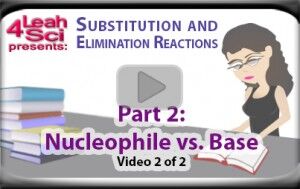 SN1 SN2 E1 Series: Video 5
SN1 SN2 E1 Series: Video 5
Once you understand the similarities and differences between nucleophiles and bases, you need to understand how to differentiate the molecules that prefer to act as just one or the other.
This video helps you understand strong bases that make weak nucleophiles and strong nucleophiles that are weak bases.
(Watch on YouTube: Nucleophile vs Base 2. Click CC on bottom right for transcript.)
<– Watch Previous Video: Nucleophile And Base Analysis for Substitution and Elimination Reactions Part 1
–> Watch Next Video: Polar Protic, Aprotic, and Non-Polar Solvents in Substitution and Elimination Reactions
This is Video 5 in the Nucleophilic Substitution and Beta Elimination Video Series. Click HERE for the entire series.
Ready to test your substitution/elimination skills? Try my FREE SN1 SN2 E1 E2 Practice Quiz.


